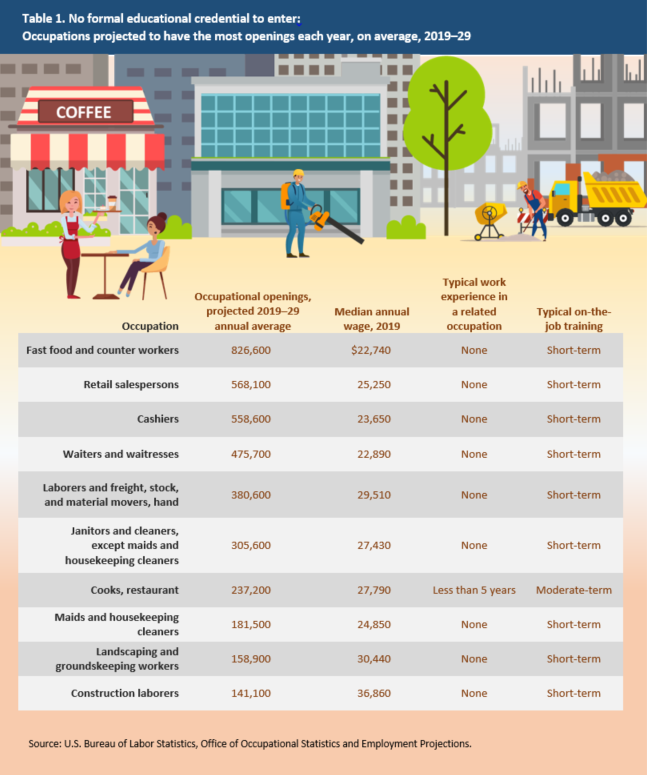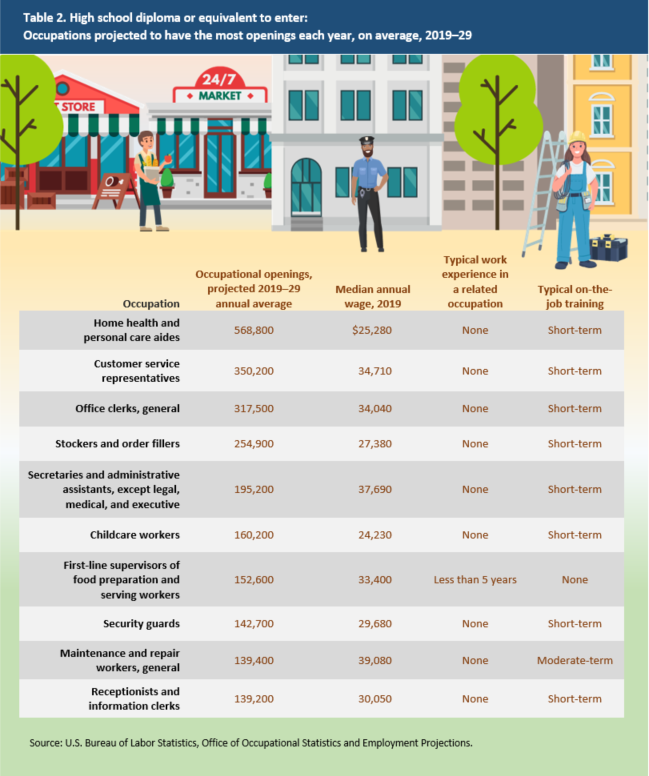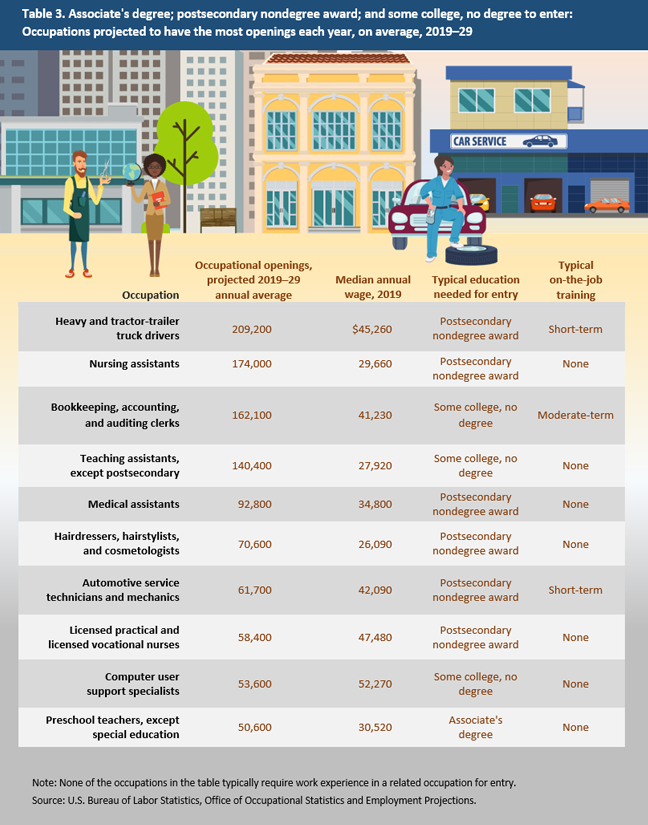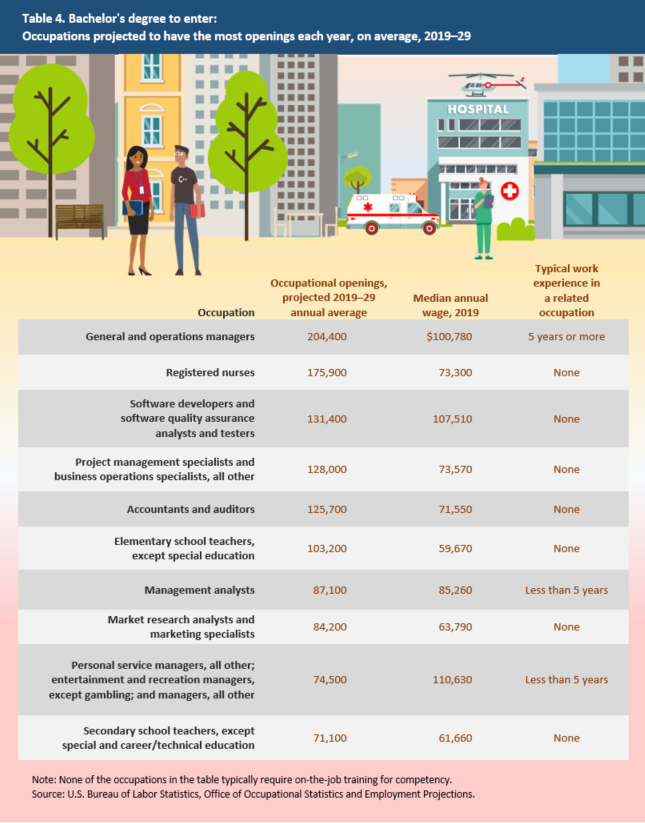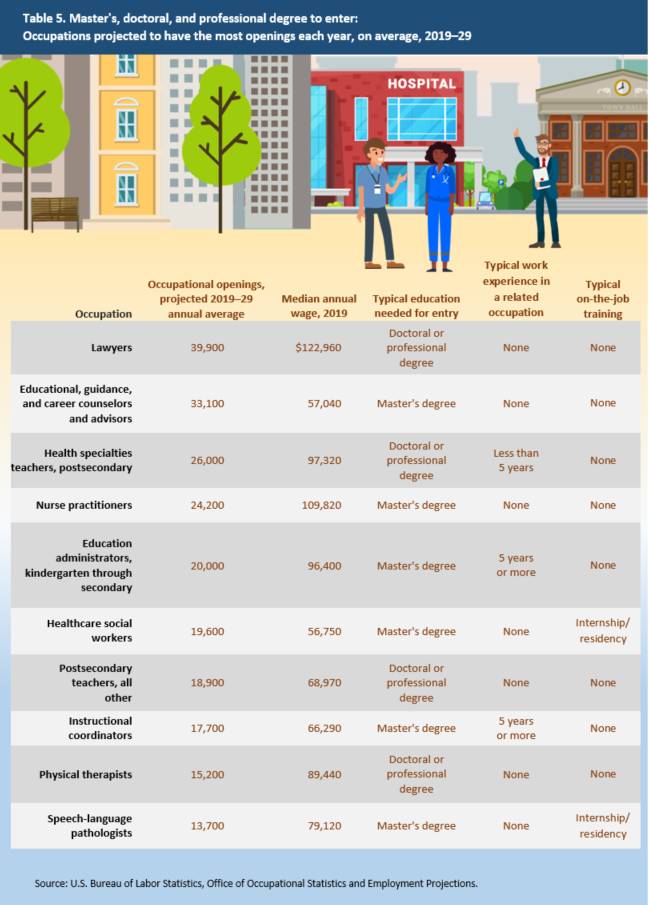What to Accomplish

미국에서 대학을 다닌다는 말은 무한한 가능성을 열게 된다는 말과 같다고 할 수 있습니다.
충분한 연구와 준비, 부단한 노력과 의지, 지침 없는 끈기와 열정 등이 필요하지만,
동시에, 확고한 목적의식도 요구됩니다. 또한 구체적인 목표도 정할 수 있어야 합니다.
이러한 측면에서, 미국에서의 학업을 통해 이루고자 하는 것들이 무엇인지,
그 이유는 무엇인지에 대해, 충분히 고민하고, 또 글로 정리할 수 있으면 좋겠습니다.
이를 위해, 적어도 이런 질문들에 대한 답들은 찾을 수 있어야 하겠지요.
- 나는 어떤 분야에 관심이 있나? (흥미 – 나는 어떤 일을 할 때 행복한가?)
- 나는 어떤 것들을 잘 하나? (적성 – 내가 남들보다 비교적 잘 하는 것들이 무엇인가?)
- 위 두 질문에 비추어, 나는 어떤 직업을 통해 더욱 행복할 수 있을까?
- 그 직업을 갖기 위해, 어떤 학업이 필요한가? 그리고, 최종학위는 무엇이 되어야 할까?
- 그 최종학위는 어느 학교에서 무슨 전공으로 받아야 할까?
아래, 미국 연방 노동부에 있는 글 하나를 옮겨놓았습니다. 참고하시기 바랍니다.
사실, https://www.bls.gov/ 에 있는 정보 모두가 참으로 유익합니다.
이 외에도, https://www.career.go.kr/ 에 있는 “진로심리검사”, 그리고
https://www.mynextmove.org/ 에 있는 다양한 정보들도 매우 유용합니다.
이러한 자료들도 충분히 참조하여,
“나는 미국대학유학을 통해 궁극적으로 무엇을 이루고자 하는지”
분명한 목표를 정하실 수 있기를 바랍니다.
Education level and projected openings, 2019–29
Elka Torpey – October 2020
Perhaps you aspire to an associate’s degree, or you’re determined to get a doctorate. Or maybe you have no plans for formal education. Whatever your goal is, the U.S. Bureau of Labor Statistics (BLS) has data by education level that show which occupations are expected to have the most openings over the coming decade.
BLS makes long-term employment projections for nearly 800 detailed occupations. Each occupation is assigned to the education level that’s typically required for workers to enter. This article highlights 50 of the occupations that BLS projects to have the most openings each year, on average, from 2019 to 2029. These occupational openings are grouped by education level as follows:
- No formal educational credential
- High school diploma or equivalent
- Associate’s degree; postsecondary nondegree award; and some college, no degree
- Bachelor’s degree
- Master’s, doctoral, and professional degrees
Across all occupations, BLS projects more than 17 million openings each year, on average, from 2019 to 2029. Openings arise from two sources: when new jobs are created from employment growth and when workers leave an occupation permanently, such as to transfer to another occupation or to retire.
Keep reading to see tables showing projected openings and median annual wages at each of the education levels. (A median wage is the point at which half of workers made more than the amount, and half made less. In 2019, the median annual wage for all workers was $39,810.) The tables also indicate whether workers typically need experience in a related occupation for entry and whether on-the-job training to attain competency is typically required.
No formal educational credential
BLS classifies 103 occupations as not typically needing any formal educational credential. Table 1 shows the 10 occupations in this group that are projected to have the most openings each year, on average, from 2019 to 2029.
The occupations in table 1 account for about 68 percent of all openings projected at this education level. Fast food and counter workers is projected to have more openings than any other occupation in the economy: more than 800,000 each year, on average, from 2019 to 2029. Although most of these openings are expected from the need to replace workers who leave this large occupation each year, BLS also projects many new jobs to be created.
Each of the occupations in table 1, like most at this education level, had wages below the median for all occupations. The occupations in the table may not require formal education, but they typically involve training on the job, often for 1 month or less.
High school diploma or equivalent
There are 322 occupations that typically require a high school diploma or the equivalent (such as a GED)—nearly twice as many occupations as at any other level of education. Table 2 shows occupations at the high school level that are projected to have the most openings annually, on average, from 2019 to 2029.
Projected openings in the occupations in table 2 account for about 37 percent of the total number of openings expected in occupations at this education level. With more than a half million openings expected each year, on average, over the decade, home health and personal care aides is projected to have the most openings of the occupations in table 2. Many of the openings for these aides are expected to be from newly created jobs because this is also one of the fastest growing occupations.
Although none of the occupations in this table had wages higher than the median for all occupations, more than half of the occupations at this education level did. In addition to a high school diploma or equivalent, most of the occupations in table 2 also typically require on-the-job training for workers to gain competency in their tasks.
Associate’s degree; postsecondary nondegree award; and some college, no degree
Nearly 100 occupations typically require some education beyond a high school diploma but less than a bachelor’s degree. Most of these occupations typically require an associate’s degree or a postsecondary nondegree award; six typically require some college but no degree. Table 3 shows the 10 occupations at these education levels that are projected to have the largest numbers of openings each year, on average, over the decade. (See table 3.)
The occupational openings shown in the table account for about 62 percent of all openings projected in occupations that typically require an associate’s degree, postsecondary nondegree award, or some college but no degree. Heavy and tractor trailer truck drivers is projected to have the most openings of the occupations in table 3: about 209,200 each year, on average, from 2019 to 2029. The largest number of those openings is expected to be from the need to replace workers who leave the occupation permanently rather than from new jobs due to employment growth.
Half of the occupations in table 3 had wages that were higher than the median for all occupations. On-the-job training to attain competency is typically required in a few of the occupations in the table.
Bachelor’s degree
A bachelor’s degree is typically required for entry in 169 occupations. Table 4 shows the occupations at this education level projected to have the most openings each year, on average, from 2019 to 2029.
About 40 percent of all openings projected in the bachelor’s-level group are in the occupations shown in table 4. General and operations managers is projected to have the most openings (204,400) annually, on average, of any occupation that typically requires a bachelor’s degree for entry. This large occupation employs workers across many industries; specific entry requirements and prospects vary.
Each of the occupations in table 4 had wages that were higher than the median for all occupations. That’s not surprising, given that nearly every occupation at this education level had higher-than-median wages. A few of the occupations in the table typically require work experience in a related occupation in addition to a bachelor’s degree, but none typically requires on-the-job training for workers to attain competency.
Master’s, doctoral, and professional degrees
In 36 occupations, a master’s degree is typically required for entry; 63 occupations typically require a doctoral or professional degree. Table 5 shows the 10 occupations at these education levels that are projected to have the most openings annually, on average, from 2019 to 2029.
The occupational openings in table 5 account for about 46 percent of all openings projected in master’s, doctoral, and professional degree-level occupations. With 39,900 openings each year, on average, from 2019 to 2029, lawyers is projected to have more openings than any other occupation at these levels of education. Most of those openings are expected to be from the need to replace workers who leave the occupation.
Wages for each of the occupations in table 5 were higher than the median for all occupations. In fact, of the 99 occupations at these education levels, only rehabilitation counselors ($35,950)—not shown in the table—had a wage below the median. High wages are more common in occupations that typically require many years of school and experience or training, as the ones in table 5 do, than in occupations that have few requirements.
For more information
Learn more about the occupations in this article and hundreds of others in the Occupational Outlook Handbook (OOH). The OOH has lots of detail, including what workers do and their pay, job outlook, and typical education requirements.
The BLS Employment Projections program has additional information on education and training, as well as occupational openings. For example, Table 5.4 shows the typical entry-level education and training assignments for all occupations, according to BLS, and Table 5.3 shows workers’ educational attainment within occupations based on data from the American Community Survey.
Elka Torpey is an economist in the Office of Occupational Statistics and Employment Projections, BLS. She can be reached at torpey.elka@bls.gov.

